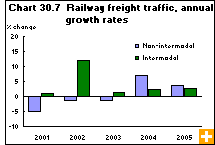Common menu bar links
Moving cargo by rail
Archived Content
Information identified as archived is provided for reference, research or recordkeeping purposes. It is not subject to the Government of Canada Web Standards and has not been altered or updated since it was archived. Please contact us to request a format other than those available.
Every day, freight trains chug through our communities, hauling long lines of boxcars and containers of consumer and industrial goods from sources around the world.
These containers form part of a freight transport system that spans the globe. It is an intermodal system because it uses more than one transportation mode—ships, trucks or rail cars—to move freight. Given Canada’s vast distances, rail is central to getting the containers to their final destination.
Intermodal rail transport made steady gains from 2000 to 2005, growing an average 4.9% per year, while loads increased from 21.9 million tonnes to 27.8 million tonnes. The Western provinces accounted for most of this growth, with a yearly average increase of 11.6%, much greater than the 3.2% increase for the provinces east of Manitoba.
Shipping goods via standardized containers reduces cargo handling, making it faster, more cost effective, secure and reliable, while reducing damage and loss. Most of the containers drivers see on trains are carrying goods made in Asia or the United States destined for Canada’s retail stores.
Raw materials are not typically transported in cargo containers. Such non-intermodal transport is still dominant in Canada, accounting for about 90% of rail tonnage. In 2005, this totalled 260.8 million tonnes. The growth in tonnage has been strong—rising 6.9% in 2004 and 3.8% in 2005—and was largely increased shipments of coal, lumber and iron ore, which together made up more than one-third of non-intermodal railway carloadings in 2005. Non-intermodal traffic grew by 2.4% over the 2000 to 2005 period, from 254.7 to 260.7 million tonnes.



